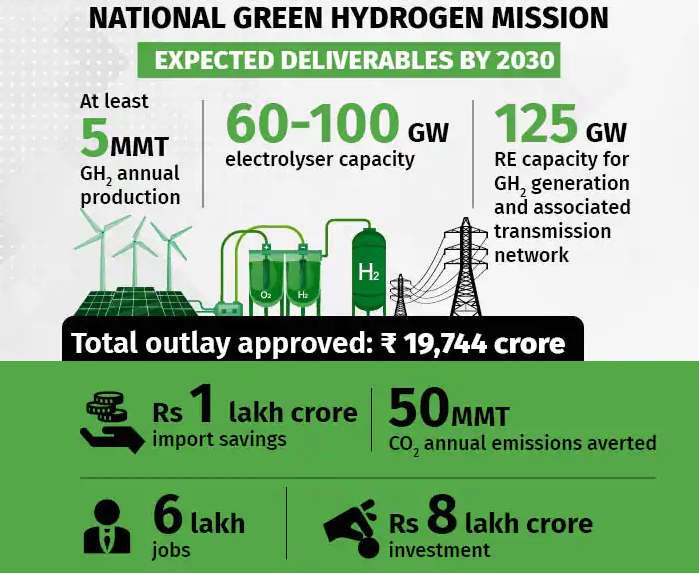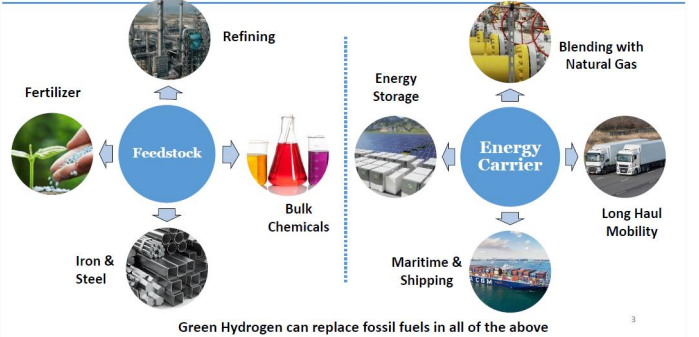National Green Hydrogen Mission
2023 APR 3
Mains >
Economic Development > Indian Economy and issues > Renewable energy
IN NEWS:
- To achieve Net Zero by 2070, increasing renewable energy use across all economic spheres is central to India's energy transition, and green hydrogen is considered a promising alternative for enabling this transition.
- The National Green Hydrogen Mission aims to put India on the world map as a leader in the green hydrogen transition.
ABOUT NATIONAL GREEN HYDROGEN MISSION:
- The Mission is under the Ministry of New and Renewable Energy
- It is a program to incentivise the commercial production of green hydrogen and make India a net exporter of the fuel.
- The Mission will facilitate demand creation, production, utilization and export of Green Hydrogen.
- Sub Schemes of the Mission:
- Strategic Interventions for Green Hydrogen Transition Programme (SIGHT):
- It will fund the domestic manufacturing of electrolysers and produce green hydrogen.
- Green Hydrogen Hubs:
- States and regions capable of supporting large scale production and/or utilization of hydrogen will be identified and developed as Green Hydrogen Hubs.
---------------------------
HYDROGEN:
- Hydrogen (H) is a colourless, odourless, tasteless, flammable gaseous substance. A molecule of hydrogen is the simplest possible molecule.
- Elementary hydrogen finds its principal industrial application in the manufacture of ammonia (NH3).
- Hydrogen is a clean fuel when burned with oxygen. It can be used in fuel cells or internal combustion engines. It is also used for spacecraft propulsion.
|
TYPES OF HYDROGEN BASED ON EXTRACTION METHODS:
Depending on the nature of the method of its extraction, hydrogen is categorised into three categories, namely, Grey, Blue and Green.
- Grey Hydrogen:
- It is produced via coal or lignite gasification (black or brown), or via a process called steam methane reformation (SMR) of natural gas or methane (grey). These tend to be mostly carbon-intensive processes.
- Blue Hydrogen:
- It is produced via natural gas or coal gasification combined with carbon capture storage (CCS) or carbon capture use (CCU) technologies to reduce carbon emissions.
- Green Hydrogen:
- It is produced using electrolysis of water with electricity generated by renewable energy.
|
BENEFITS OF GREEN HYDROGEN:
- Environmentally sustainable:
- Green Hydrogen is a clean fuel that produces only water, electricity, and heat.
- For instance, Hydrogen can potentially replace the coal and coke in iron and steel production. Steel manufacturing is one of the largest carbon emitters in the world, decarbonising this sector using green hydrogen is expected to have significant impact on our climate goals.
- Reduce fossil fuel imports:
- At present, hydrogen produced from natural gas is widely utilized for production of nitrogenous fertilizers, and petrochemicals.
- Substituting this with green hydrogen could allow use of renewable energy in these important sectors and reduce import dependence.
------------------
- Rapid R&D growth:
- Researches in hydrogen as a fuel are gaining momentum worldwide.
- As new technologies create cheaper production methods, hydrogen can become cost competitive.
- Energy density:
- Hydrogen has a strong octane rating and hence can deliver a tremendous amount of energy.
- Hydrogen-based transport:
- Fuel cell electric vehicles (FCEVs) run on hydrogen fuel and have no harmful emissions.
- While Battery Electric Vehicles (BEVs) are dependent on imported raw materials like lithium and cobalt for lithium-ion batteries, the hydrogen fuel cell supply chain can be wholly indigenized, making India Aatmanirbhar in the clean transportation segment.
- Storage:
- Electricity can be difficult to store and convey over long distances. But by using electricity to extract green hydrogen, both storage and transport become simple.
- Energy security:
- Green Hydrogen can be locally produced, meaning countries can power themselves independently without having to rely on external energy suppliers.
- This can save India from potential geopolitics-led energy crises like oil blockades.
CHALLENGES:
- Green hydrogen is relatively expensive:
- The cheapest way to manufacture hydrogen is to rely on fossil fuels such as coal and natural gas, which produce carbon emissions.
- However, green hydrogen produced from renewable energy is relatively expensive.
- For instance, it costs between 0.9 and 1.5 USD to produce a kilogramme of hydrogen from coal and anywhere from 3.5 to 5.5 USD per kg to produce it from renewable energy sources..
- Storage:
- Weight and Volume:
- The weight and volume of hydrogen storage systems are presently too high, resulting in inadequate vehicle range compared to conventional petroleum fuelled vehicles.
- Safety concerns:
- Because of its high flammability, high diffusivity and very low density as a gas, hydrogen needs bulky storage facilities and safety systems. This makes it unattractive for public use.
- Regulatory regime:
- Applicable codes and standards for hydrogen-based systems have not been established in India.
- It is not easy to replace existing infrastructure:
- Creating infrastructure that can support hydrogen as fuel requires huge investment.
- This is why it becomes highly expensive to replace gasoline.
WAY FORWARD:
- Regulations and standards:
- Development of regulations and standards as one of the key requirements for commercialization of Hydrogen-fuelled vehicles.
- Regulations and standards will help to overcome technological barriers to commercialization, facilitate manufacturers’ investment in building Hydrogen fuelled vehicles.
- Developing standards:
- India must engage with international hydrogen industry for identifying standards for commercialization of hydrogen energy systems, and we must participate with Standards Development Organizations to develop Hydrogen standards
- Human Resource Development:
- Human resource development is the key to sustained R&D program on green Hydrogen.
- Green hydrogen production process and fuel cell technology requires expertise from various fields such as electrical, mechanical, chemistry, physics, biotechnology, management etc.
- Awareness:
- The most important factor for fostering support and decreasing opposition to the introduction of Hydrogen technologies is increased knowledge.
- The general public must be given further education, along with decision-makers within government and industry, regulators and policy developers, academics etc.
- Public Private Partnership
- Coordination between industry and government can facilitate smooth commercialization of Hydrogen and fuel cell systems.
- A national ‘Fuel Cell Institute’ can be created to:
- Bring all the concerned stakeholders such as Ministries, Departments, academicians, researchers and industry under one umbrella to work together in a systematic manner
- Develop a mechanism to incentivize the individuals and the institutions involved in the development of fuel cell.
- Lower GST rate and subsidy:
- Use of green hydrogen could be promoted in various industries by making its cost comparable to the fuel it would substitute, and this could be done by a combination of a lower GST rate, as has been done for Electric Vehicles (EVs), and/or a direct subsidy per kg of green hydrogen used.
CONCLUSION:
- With proactive collaboration among innovators, entrepreneurs and government, green hydrogen has the potential to drastically reduce CO2 emissions, fight climate change, and put India on a path towards net-zero energy imports. It will also help India export high-value green products making it one of the first major economies to industrialise without the need to ‘carbonise’.
PRACTICE QUESTION:
Q. “Green Hydrogen has often been touted as a fuel of the future”. In this context, discuss the prospects and challenges for India to switch to a green hydrogen-based economy.

